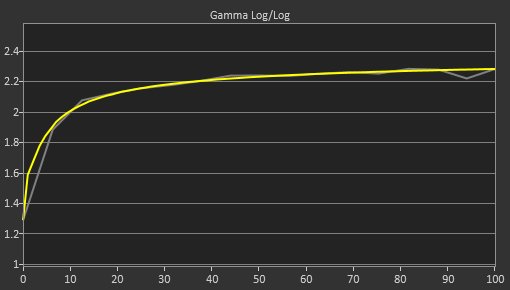The LG 24MP59G-P is a decent 1080p IPS gaming monitor with great wide viewing angles and good gaming features, including AMD FreeSync VRR support. It is limited to a 75 Hz refresh rate, which isn't enough of an improvement over 60 Hz to please most gamers. Unfortunately, like most IPS monitors, it doesn't look as good in a dark room, and it has a fixed stand with bad ergonomics that can't be VESA mounted.
Our Verdict
The LG 24MP59G is an alright monitor overall. It is best suited as a budget gaming monitor, with a good response time, low input lag, and FreeSync support. Office users will likely find the resolution insufficient for multitasking, and the fixed stand makes it hard to place in an ideal viewing position. It does not support HDR, and dark room performance isn't ideal.
- Good gaming features, including FreeSync VRR.
- Image remains accurate when viewed at an angle.
- Bad ergonomics.
- Mediocre dark room performance.
The LG 24MP59G is a decent monitor for office use. It has a fixed stand that can only tilt, so it may be difficult to place in an ideal position. It is limited by the 24" size and 1080p resolution, which isn't ideal for multitasking or full-time work. It has great reflection handling and can get bright enough for most rooms. Like most IPS monitors, it has wide viewing angles, great for sharing your work with a nearby coworker.
The LG 24MP59G is a decent monitor for gaming. It has a fast response time, but there is more motion blur than more expensive models. It has excellent low input lag, and it supports AMD FreeSync, great for Xbox One owners. Unfortunately, it is limited to a 1080p resolution which isn't as immersive as newer 4k or 1440p monitors.
The LG 24MP59G is okay for multimedia. It has great wide viewing angles, good for sharing the latest trends with some friends, but the small 24" screen and 1080p resolution is limiting. It also doesn't look as good in a dark room due to the mediocre contrast ratio and poor black uniformity.
The LG 24MP59G is an okay monitor for media creation. Unfortunately, it isn't ideal for working on large projects due to the 1080p resolution and 24" screen. It has a very good color gamut, but the Adobe RGB coverage isn't ideal for professionals doing photo or video editing.
The LG 24MP59G doesn't support HDR.
Changelog
- Updated Jul 02, 2021: Changed height adjustment result from 'N/A' to '0' to match our methodology.
- Updated Jan 17, 2019: We tested the monitor's compatibility with NVIDIA's new FreeSync driver. See our full investigation into NVIDIA's FreeSync Drivers here.
- Updated Oct 30, 2018: Review published.
- Updated Oct 28, 2018: Our testers have started testing this product.
Check Price
Differences Between Sizes And Variants
We tested the 24" LG 24MP59G-P. It is also available in 27" (27MP59G-P), but we don't know if they perform the same.
If someone comes across a different type of panel or if their LG 24MP59G-P doesn't correspond to our review, let us know and we will update the review. Note that some tests such as the gray uniformity may vary between individual units.
| Model | Size | Resolution | Refresh Rate | Notes |
| 24MP59G-P | 24" | 1080p | 75 Hz | FreeSync |
| 27MP59G-P | 27" | 1080p | 75 Hz | FreeSync |
| 29UM69G-B | 29" | 2560x1080 | 75 Hz | FreeSync |
The 24MP59G we reviewed was manufactured in July 2018.
Popular Monitor Comparisons

The LG 24MP59G-P is a decent 1080p budget gaming monitor. It faces strong competition in its price range, and you can get much better monitors for only a bit more. See our recommendations for the best 1080p monitors, the best budget gaming monitors, and the best gaming monitors.
The LG 24MP59G-P and the LG 24GL600F use different panel technologies, each with their strengths and weaknesses. The 24MP59G-P is better for most uses, with wider viewing angles and better uniformity. The 24GL600F is a bit better for gaming though, with a much faster response time and faster refresh rate.
The LG 24MP59G-P and LG 29UM69G-B are nearly identical, the 29UM69G is simply a wider version of the 24MP59G. Both monitors have a 75 Hz refresh rate with FreeSync support. The 29UM69G has a faster response time, so fast motion looks better with less motion blur, and the wider screen is slightly better for multitasking.
The LG 24MP59G is slightly better than the Acer G257HU Smidpx. Both monitors have an IPS panel with wide viewing angles. The Acer G257HU has a simple 60Hz refresh rate and no VRR support, whereas the LG 24MP59G has a better 75Hz refresh rate, and supports FreeSync VRR. The Acer has a slightly larger, 25" screen, and a much better 1440p resolution, better for multitasking or for a more immersive gaming or multimedia experience.
The ASUS VG245H is slightly better than the LG 24MP59G-P, unless wide viewing angles are important to you. The ASUS VG245H has a TN panel, and it has an outstanding fast response time, so motion looks very clear with little motion blur. The ASUS also has an outstanding stand with excellent ergonomics, so it's much easier to place it in an ideal viewing position. The LG 24MP59G has an IPS panel, so it has much wider viewing angles, great for sharing your screen with other people.

We buy and test more than 30 monitors each year, with units that we buy completely on our own, without any cherry-picked units or samples. We put a lot into each unbiased, straight-to-the-point review, and there's a whole process from purchasing to publishing, involving multiple teams and people. We do more than just use the monitor for a week; we use specialized and custom tools to measure various aspects with objective data-based results. We also consider multiple factors before making any recommendations, including the monitor's cost, its performance against the competition, and whether or not it's easy to find.
Test Results
The LG 24UM59G has a decent design. It has a glossy bezel and modern V-shaped stand that give it a stylish look. Unfortunately, it can't be VESA mounted, and it has a very basic stand with bad ergonomics, so it can be difficult to place it in an ideal viewing position. It has decent build quality, with no obvious issues or concerns.
Update 07/02/2021: We previously had incorrectly listed the Height Adjustment as 'N/A' as opposed to '0'. The review has been updated to reflect this change, as the Ergonomics score has dropped slightly.
The LG 24MP59G-P has a fixed stand that can only tilt. There are no height adjustments and it can't swivel.
Unfortunately, it can't be VESA mounted, unlike the widescreen variant, the LG 29UM69G-B.
The LG 24MP59G has a mediocre native contrast ratio, slightly better than the Dell P2417H and the LG 29UM69G. Dark room performance is less than ideal, as blacks look gray in a dark room.
There is no local dimming feature on this monitor. The video is for reference only.
Decent peak brightness. Good enough for most rooms and slightly brighter than the HP 22CWA. There is no variation in peak brightness with different content, which is great.
HDR is not supported on this monitor.
Decent horizontal viewing angle. Like most IPS monitors, the black level remains constant when viewed from the side. Colors remain accurate to a wide angle, but not as wide as the Dell P2217H or Dell P2417H.
Great vertical viewing angles. The black level varies a bit but remains accurate at any angle. The brightness drops as you move off-axis, but is slightly better than other similar models, including the Dell P2417H.
Excellent gray uniformity. There are a few dark bands throughout, but overall there is not much dirty screen effect, which is great for browsing the web or playing sports games. In near-dark scenes, there is almost no noticeable dirty screen effect.
Out of the box, the accuracy of the LG 24MP59G is disappointing. The white balance is significantly off, and even non-enthusiasts are likely to notice it. There is also significant color error, beyond the point where we expect people to start noticing it. Gamma does not follow the target curve and is nearly flat, so some scenes are too dim while others are too bright.
After calibration, almost all errors are corrected. The white balance and color error are much better, but blues are still a bit inaccurate. Gamma follows the target curve almost perfectly.
You can download our ICC profile calibration here. This is provided for reference only and should not be used, as the calibration values vary per individual unit even for the same model due to manufacturing tolerances.
s.RGB Picture Mode: Custom (calibrated)
Adobe RGB Picture Mode: Photo
Very good color gamut. The sRGB coverage doesn't quite fill out the gamut, and some greens and blues are clipped. Adobe RGB coverage is decent, but not ideal for professional photo or video editing.
HDR is not supported on this monitor.
HDR is not supported on this monitor.
There is very little temporary image retention on the LG 24MP59G-P. Even immediately after showing a high contrast static image for 10 minutes, only a faint residual image is visible.
Great gradient performance on the LG 24MP59G. There are small vertical bands visible throughout, similar to the ViewSonic XG2402, but this shouldn't be an issue.
Response Time Off
Response Time Low
Response Time Middle
Response Time High
The LG 24MP59G-P has a good response time. The overdrive can be customized by changing the Response Time setting. We recommend using the 'Middle' setting. Higher overdrive settings have significant overshoot, but don't significantly improve the average response time.
By default, the LG 24MP59G is completely flicker-free, which is great. Enabling the 1 ms Motion Blur Reduction setting introduces 75Hz flicker, as long as the refresh rate is set to 75Hz. This makes motion appear more clear by reducing persistence blur, but the low flicker frequency may bother some people. At 60Hz, the BFI option is not available.
It is limited to a 75Hz refresh rate which may be disappointing to more serious gamers. It supports AMD FreeSync, but due to the low refresh rate it has a narrow range, and there is no Low Framerate Compensation (LFC).
Update 01/15/2019: We have tested the 24MP59G with NVIDIA's new FreeSync drivers, and had no issues. The full FreeSync range of 40-75Hz worked without any noticeable issues.
The monitor has excellent low input lag. It also supports FreeSync VRR which also has excellent low input lag.
The LG 24MP59G is a small 24" monitor, with a basic 1080p resolution that may disappoint some people.
There is a 3.5 mm analog audio out port with adjustable volume, suitable for connecting speakers or headphones. It has DisplayPort, HDMI, and VGA inputs, but no DVI.
There are a few additional features on the LG 24MP59G-P, most of which are designed to improve your gaming experience:
- Black Stabilizer. This feature adjusts the contrast and gamma to make it easier to spot objects hidden in shadows. This can be helpful in FPS games or MOBAs.
- Super Resolution+. This can help improve image sharpness when sending a non-native resolution. Since this monitor is limited to 1080p, there is not much benefit to this.
- Cross Hair. You can add a virtual, fixed cross hair on the screen, useful for games that don't have one.
- Game Presets. There are 3 preset Picture modes for different gaming genres. There is also a fourth mode that can be customized and saved.
- 1ms Motion Blur Reduction. This activates the monitor's Black Frame Insertion feature. This mode introduces backlight flicker to help reduce persistence blur.











































